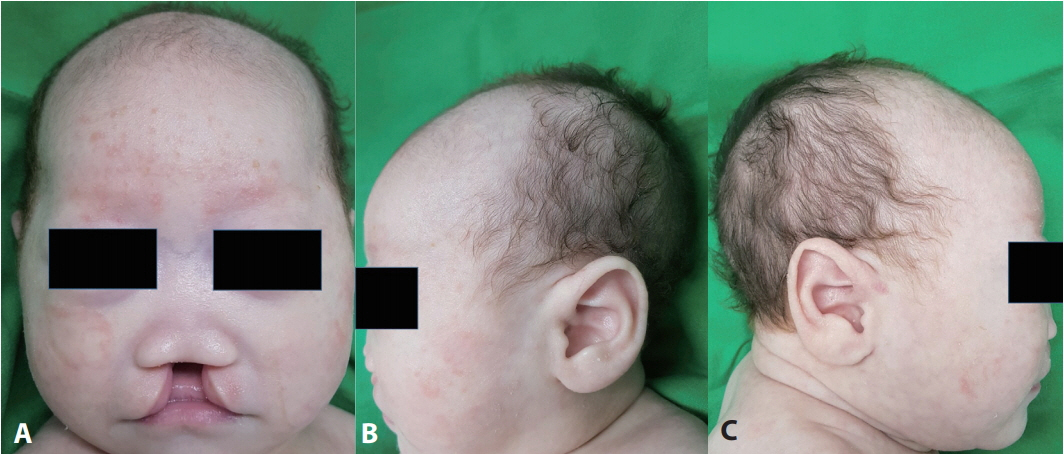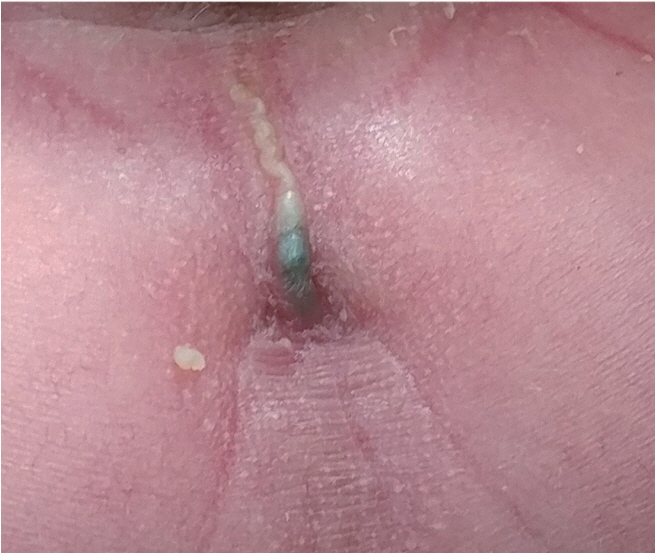Neonatal Med.
2018 Aug;25(3):131-135. 10.5385/nm.2018.25.3.131.
A Rare Case of Hyponatremia Caused by Reset Osmostat in a Neonate with Cleft Lip, Cleft Palate, and Imperforate Anus
- Affiliations
-
- 1Department of Pediatrics, Inje University Busan Paik Hospital, Inje University College of Medicine, Busan, Korea. iamgawon@paik.ac.kr
- 2Division of Pediatric Surgery, Department of Surgery, Inje University Busan Paik Hospital, Inje University College of Medicine, Busan, Korea.
- KMID: 2436130
- DOI: http://doi.org/10.5385/nm.2018.25.3.131
Abstract
- Hyponatremia is defined as a plasma sodium concentration of < 135 mEq/L. It is a common electrolyte imbalance in newborns. We report the case of a term neonate with cleft lip, cleft palate, imperforate anus, normal male karyotype, and chronic hyponatremia. On the 4th day of life, he showed hyponatremia (plasma sodium concentration 130 mEq/L) with low serum osmolality (275 mOsm/kg), high urine sodium (116.7 mEq/L), and high urine osmolality (412 mOsm/kg). His thyroid and adrenal functions were normal. Despite intravenous and oral sodium supplementation and hydrocortisone treatment, hyponatremia persisted. Brain magnetic resonance imaging showed normal results. He was diagnosed as having reset osmostat, a rare subtype of the syndrome of inappropriate secretion of antidiuretic hormone characterized by a subnormal threshold for antidiuretic hormone secretion, with hypotonic hyponatremia.
MeSH Terms
Figure
Reference
-
1. Marcialis MA, Dessi A, Pintus MC, Irmesi R, Fanos V. Neonatal hyponatremia: differential diagnosis and treatment. J Matern Fetal Neonatal Med. 2011; 24 Suppl 1:75–9.2. Baylis PH. The syndrome of inappropriate antidiuretic hormone secretion. Int J Biochem Cell Biol. 2003; 35:1495–9.3. Bartter FC, Schwartz WB. The syndrome of inappropriate secretion of antidiuretic hormone. Am J Med. 1967; 42:790–806.4. Vale BM, Morais S, Mesquita J, Mimoso G. Reset osmostat: a rare cause of hyponatraemia. BMJ Case Rep. 2015; 2015:bcr2013009111.5. Marcialis MA, Dessi A, Contu S, Fanos V. Nephrogenic syndrome of inappropriate antidiuresis: a novel cause of euvolemic hypotonic hyponatremia in newborns. Diagnosis and practical management. J Matern Fetal Neonatal Med. 2009; 22 Suppl 3:67–71.6. Thiagarajan R, La Gamma E, Dey S, Blethen S, Wilson TA. Hyponatremia caused by a reset osmostat in a neonate with cleft lip and palate and panhypopituitarism. J Pediatr. 1996; 128:561–3.7. Moritz ML, Ayus JC. Hyponatremia in preterm neonates: not a benign condition. Pediatrics. 2009; 124:e1014. –6.8. Gupta P, Mick G, Fong CT, Jospe N, McCormick K. Hyponatremia secondary to reset osmostat in a child with a central nervous system midline defect and a chromosomal abnormality. J Pediatr Endocrinol Metab. 2000; 13:1637–41.9. Modi N. Hyponatraemia in the newborn. Arch Dis Child Fetal Neonatal Ed. 1998; 78:F81–4.10. Chehade H, Rosato L, Girardin E, Cachat F. Inappropriate antidiuretic hormone secretion: long-term successful urea treatment. Acta Paediatr. 2012; 101:e39–42.
- Full Text Links
- Actions
-
Cited
- CITED
-
- Close
- Share
- Similar articles
-
- Orthodontic consideration of cleft lip and palate (Report 1)
- Tessier No. 2 Oblique Facial Cleft Not Associated with Cleft Lip or Palate: a Case Report
- Management of Swallowing and Speech Problems in Patients with Cleft Lip and Palate
- The use of classification in primary and secondary cleft lip and nose deformities in medical records
- A case of Aicardi syndrome with cleft lip and palate



